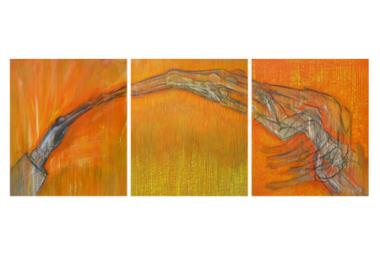It may sound like a good Jackass 3D stunt, but the fine art of getting shot from a cannon, flying through the air to land (one hopes) in a net, is a long-established tradition among the circus set. The physics of the thing, of course, lead to a beautiful trajectory. It’s also got to be a pretty big rush to fly through the air with a deafening bang and a high likelihood of black-out and/or injury.
Artist Matthias Leutrum felt compelled by the contradictions of said spectacle. About what happened next, he says, “The connotations of an explosive, menacing and almost violent event, combined with a frolicsome circus atmosphere, merged to form a slew of potent visual possibilities.”
The result of his cogitations is a group of large-scale paintings (called Human Cannonballs) that explore still images of explosive action and, in some cases, attempt to depict the explosive action with bright color and rendering of the cannonballs’ movement.
Leutrum is an interesting guy to talk to—he’s passionate about the pursuit of art, and, as a German who studied at Paris’ Ecole des Beaux-Arts, he possesses a particularly stout European artistic pedigree. Leutrum is a part-time Valley resident who teaches at The Children’s Storefront in Harlem.
Standing in the A.P.E. space on Northampton’s Main Street, he pointed out some of the concerns he addressed in filling the space with his paintings. They were the sorts of things visual artists are far more likely to notice than those of us who just peruse the artistic offerings. The main triptych, for instance, was painted with the A.P.E. space in mind. In it, the flight of a human cannonball is broken up into three segments: launch, mid-flight, and “plummet.” The triptych is primarily bright orange, and somehow the arc of the cannonball’s flight connects, whether the images are far apart or up close.
With such large-scale work—the canvases are each about as high as a door—an in-person look becomes more important. Look at them in small scale, and it’s much harder to notice that the textures Leutrum has created are major players in the visual drama. He says drawing attention away from just the figures was important, and in the middle panel, the texture, much yellower than the rest of the orange, serves to buoy the figure rocketing across the top.
A curious melding of styles is at work in Leutrum’s paintings as well. The yellow texture in his triptych, he explains, was created by applying paint thin enough to run. “Then I turned the canvas,” he says, “and did it again.” The result is a remarkably organic texture, the sort of almost-rectangular structures nature might produce in a plant. But look elsewhere in his work, and something an aesthetic world away is happening.
In some of his paintings, a stark black backdrop forces viewers’ attention to the figures caught in mid-trajectory, frozen in the midst of flying. It’s tough to pin down precisely why, but these dramatic figures seem to be cousins of the idealized images in mid-century Social Realism.
Leutrum explains that he doesn’t seek out a “signature style,” preferring instead to focus his work around an idea. That unusual choice gives him wide latitude, and allows him to get at the core of what draws him to an idea. In many images, there are visual cues that the paintings come from the same artist—figures with sketchy borders, a freedom with dripping. But in some, entirely different styles emerge. A boy in blue jeans is caught in mid-flight, and he’s rendered with far more obvious exactitude than his cannonball relatives. So what is it exactly that Leutrum wants to paint his many-styled way toward understanding?
If you believe the artist himself—never a sure bet—the multiplicity of answers to that question includes something of a call to don your own cannonballing helmet: “Is the passive surrender of the protagonists to this strange ritual an apt analogy for the way we might experience our own personal trajectories?””
Human Cannonballs: Through Oct. 30, A.P.E. at Window, 126 Main St., Northampton, (413) 586-5553, www.apearts.org.



